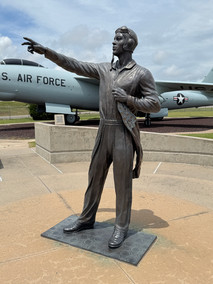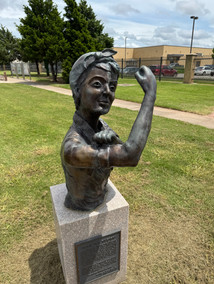Charles B. Hall Airpark(19)
- Jonathan Elmore

- Jun 30
- 2 min read
Updated: Jul 16
OKLAHOMA CITY
Sometimes I just need to see giant airplanes up close. I don't know why exactly, but I do. I remember my first flight. It was in a four seater. I was about 8 years old at the Methodist's vacation bible school in Drummond, Oklahoma. The group I was in was being really noisy and so one of the leaders said, "Whoever is the quietest this week will get to go on an airplane ride this weekend." Well, I was already a quiet kid, but he told my parents, "I didn't hear a single word out of him all week. Is he okay?" My parents laughed but I got my plane ride. Maybe that started my love of planes.
When I saw that there was a display of planes in front of Tinker AFB in OKC, I knew I had to go find it. I panicked a little because GPS was taking me to the front gate of the base and I didn't want to go in. But just before the gate there's a spot to make a U-turn into the parking lot of the airpark. I parked and noticed a sign that said there was also a Medal of Honor Memorial nearby, so I definitely had to check it out too.
So, why Charles B. Hall? I did some research and this guy deserves his own airfield and statue! When WWII broke out, he dropped out of college and enlisted in the Army Air Corp where he passed the grueling aviation cadet training. He became a 2nd Lieutenant in the 99th Pursuit Squadron in North Aftrica. The 99th was nicknamed the "Red Tails" and he would become the first African-American to earn not one but three air victories during his time there. He also earned the Distinguished Flying Cross and was congratulated by General Eisenhower for his efforts. By the time he got out of the military, he had reached the rank of Major. After his time in the military, he tried to get work in the private sector as a pilot, but as most of you know, in those days black folks were treated disrepectfully in many workplaces and weren't even allowed to be in others like commercial airlines. Amazing how a guy like Charles can risk his life to defend our freedom, but he's not allowed to fly a groups of people around the country simply because of the color of his skin. He would later teach and fly with the Tuskegee Airmen in numerous campaigns earning a multitude of accolades for his fellow airmen. I'm pretty sure that's the main definition of a patriot.
Charles moved to Oklahoma City in 1948 and worked in a drugstore until he got work at Tinker in '49. He worked there until 1967 and then took a job with the FAA. This airpark is dedicated to Charles Blakesly "Buster" Hall and I'm honored to have seen it and learned about this great American.
N. Air Depot Blvd, Oklahoma City
Free Parking and restroom on site.
Jonathan Elmore ©2025


























































